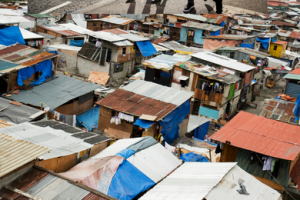Welcome back, readers!
This is a special blog post. This edition is written by Connor Cronin, our new intern at the One Health Center.
She is very excited to share her thoughts with you about Sustainable Development Goal 11 and One Health. As many of you already know, SDG 11 is focused on making cities and human settlements inclusive, safe, resilient, and sustainable. We are sure you’ll find this blog post to be an informative and interesting read.
So sit back, relax, and enjoy Connor’s take on this important SDG.
We hope you have a great time reading!
Sustainable Development Goal (SDG) 11 is to “make cities inclusive, safe, resilient, and sustainable” [1]. More than half of the global population lives in cities and this is only expected to increase [1]. With proper planning and management, cities can become sustainable and inclusive communities that prioritize the health of the people and the environment within urban spaces.

In 2020, more than one billion people lived in informal settlements [1]. These settlements are often overcrowded and lack formal recognition from their government, and as a result, they lack the necessary resources and services to have adequate living conditions. There are minimal, if any, sewage services, clean water, waste collection, or health services [2]. These factors, coupled with
overcrowding, make infectious diseases spread rapidly. Due to a lack of accessible health care and not being able to afford to miss any work, residents are incentivized to self-treat using cheap, easily accessible, and often unnecessary antibiotics [3].
SDG 11 hopes to address these issues with its target of ensuring access to adequate, safe, and affordable housing and basic services for all by 2030 [1]. By achieving this goal, there would be significantly less exposure to diseases and pollutants. Proper housing can also slow disease spread, as it would diminish transmission, resulting from excessive exposure due to overcrowding. Also, providing basic health care services would ensure people were being diagnosed and treated for the proper ailment, decreasing the use of unnecessary antibiotics, and therefore, decreasing rates of antimicrobial resistance (AMR).

Cities are known to be major cultural and economic hubs, but they could also be considered a hub for pollution. Cities account for 80% of global greenhouse gas (GHG) emissions [1]. The transportation sector is one of the largest sources of GHGs and it is increasing as the number of vehicles on the roads continues to rise [4]. SDG 11 pushes for improvements in public transportation systems, as this would not only increase community accessibility and safety but also, it can be used to address pollution resulting from privately-owned vehicles.
The World Health Organization (WHO) has established guidelines for what is considered a safe air quality threshold, which is exceeded for 99% of populations living in urban populations [1]. This health crisis needs to be addressed quickly, as ambient air pollution accounts for 4.2 million annual premature deaths. This is particularly true in low- and middle-income countries, accounting for 91% of these deaths [1]. Imparting regulations for air quality would improve the quality of life for city residents and the surrounding environment which is also at high risk due to air pollution.
By making a city “inclusive, safe, resilient, and sustainable”, the health of the residents will vastly improve. A truly sustainable system must address these complex health concerns before moving forward. By protecting the health of the environment and living organisms within, the city is also protecting culture and promoting longevity.
By: Connor Cronin | One Health Intern
[1] https://www.un.org/sustainabledevelopment/cities/
[3] https://www.tandfonline.com/doi/full/10.1080/09581596.2021.1994526
[4] https://www.epa.gov/ghgemissions/sources-greenhouse-gas-emissions
by One Health Center of Excellence
Source: UF/IFAS Pest Alert
Note: All images and contents are the property of UF/IFAS.



